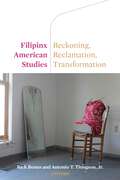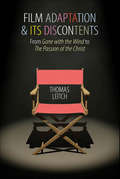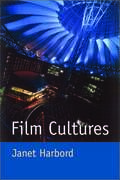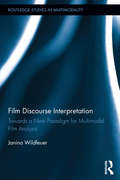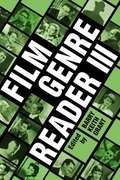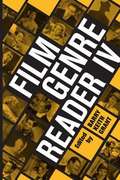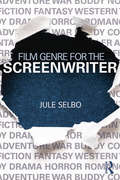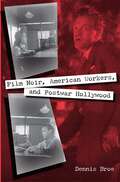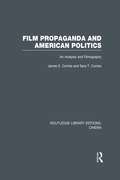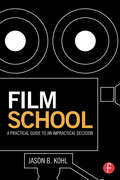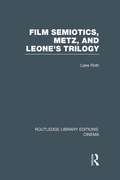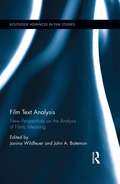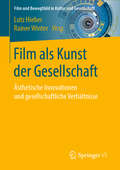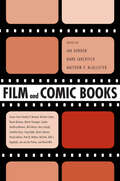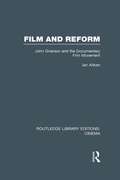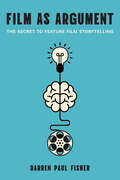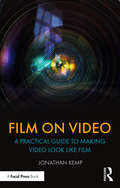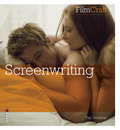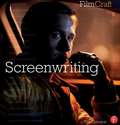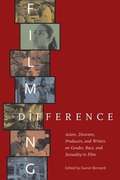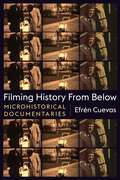- Table View
- List View
Filipinx American Studies: Reckoning, Reclamation, Transformation
by Rick Bonus and Antonio T. TiongsonThis volume spotlights the unique suitability and situatedness of Filipinx American studies both as a site for reckoning with the work of historicizing U.S. empire in all of its entanglements, as well as a location for reclaiming and theorizing the interlocking histories and contemporary trajectories of global capitalism, racism, sexism, and heteronormativity. It encompasses an interrogation of the foundational status of empire in the interdiscipline; modes of labor analysis and other forms of knowledge production; meaning-making in relation to language, identities, time, and space; the critical contours of Filipinx American schooling and political activism; the indispensability of relational thinking in Filipinx American studies; and the disruptive possibilities of Filipinx American formations. A catalogue of key resources and a selected list of scholarship are also provided. Filipinx American Studies constitutes a coming-to-terms with not only the potentials and possibilities but also the disavowals, silences, and omissions that mark Filipinx American studies. It provides a reflective and critical space for thinking through the ways Filipinx American studies is uniquely and especially suited to the interrogation of the ongoing legacies of U.S. imperialism and the urgencies of the current period.Contributors: Karin Aguilar-San Juan, Angelica J. Allen, Gina Apostol, Nerissa S. Balce, Joi Barrios-Leblanc, Victor Bascara, Jody Blanco, Alana Bock, Sony Coráñez Bolton, Lucy Mae San Pablo Burns, Richard T. Chu, Gary A. Colemnar, Kim Compoc, Denise Cruz, Reuben B. Deleon, Josen Masangkay Diaz, Robert Diaz, Kale Bantigue Fajardo, Theodore S. Gonzalves, Vernadette Vicuña Gonzalez, Anna Romina Guevara, Allan Punzalan Isaac, Martin F. Manalansan IV, Dina C. Maramba, Cynthia Marasigan, Edward Nadurata, JoAnna Poblete, Anthony Bayani Rodriguez, Dylan Rodríguez, Evelyn Ibatan Rodriguez, Robyn Magalit Rodriguez, J. A. Ruanto-Ramirez, Jeffrey Santa Ana, Dean Itsuji Saranillio, Michael Schulze-Oechtering, Sarita Echavez See, Roy B. Taggueg Jr.
Film Adaptation and Its Discontents: From Gone with the Wind to The Passion of the Christ
by Thomas LeitchMost books on film adaptation—the relation between films and their literary sources—focus on a series of close one-to-one comparisons between specific films and canonical novels. This volume identifies and investigates a far wider array of problems posed by the process of adaptation. Beginning with an examination of why adaptation study has so often supported the institution of literature rather than fostering the practice of literacy, Thomas Leitch considers how the creators of short silent films attempted to give them the weight of literature, what sorts of fidelity are possible in an adaptation of sacred scripture, what it means for an adaptation to pose as an introduction to, rather than a transcription of, a literary classic, and why and how some films have sought impossibly close fidelity to their sources. After examining the surprisingly divergent fidelity claims made by three different kinds of canonical adaptations, Leitch's analysis moves beyond literary sources to consider why a small number of adapters have risen to the status of auteurs and how illustrated books, comic strips, video games, and true stories have been adapted to the screen. The range of films studied, from silent Shakespeare to Sherlock Holmes to The Lord of the Rings, is as broad as the problems that come under review.
Film Cultures
by Dr Janet Harbord'Film Cultures is thought-provoking and challenging. By opening film theory up to the many simultaneous networks of relation (that is, the cultures) of film, it asks both viewer and student to take film more seriously' - Communication Research Trends `Film Cultures weaves together insights from cultural theory and film studies to provide a complex and absorbing theoretical account of contemporary film culture. Harbord writes with authority, imagination and wit and her delicate deployment of modernist and postmodernist cultural accounts makes rewarding reading' - Christine Geraghty, Professor of Film and Television, University of Glasgow Film Cultures argues that our tastes for film connect us to social, spatial and temporal networks of exchange and meaning. Whether we view film in the multiplex, arthouse or the gallery, as cinema premiere, video hire or from a cable channel, whether we approach film as a singular object or a hypertext linked to ancillary products, our relationship to film is inhabiting a culture. Shifting the focus of film analysis from the text to paths of circulation, Film Cultures questions how film connects us to social status, and national and global affiliations.
Film Discourse Interpretation: Towards a New Paradigm for Multimodal Film Analysis (Routledge Studies in Multimodality)
by Janina WildfeuerThis book contributes to the analysis of film from a multimodal and textual perspective by extending formal semantics into the realm of multimodal discourse analysis. It accounts for both the inferential as well as intersemiotic meaning making processes in filmic discourse and therefore addresses one of the main questions that have been asked within film theory and multimodal analysis: How do we understand film and multimodal texts? The book offers an analytical answer to this question by providing a systematic tool for the description of this comprehension process. It aims to advance knowledge of the various resources in filmic texts, the ways the resources work together in constructing meaning and the ways people understand this meaning construction. This new approach to film interpretation is thus able to remodel and improve the classical paradigm of film text analysis.
Film Genre Reader III
by Barry Keith GrantSince 1986, Film Genre Reader has been the standard reference and classroom text for the study of genre in film, with nearly 20,000 copies in print. Barry Keith Grant has again revised and updated the book to reflect the most recent developments in genre study. This third edition adds new essays on teen films, the question of genre hybridity, and neo-noir and genre in the era of globalization, along with an updated bibliography.
Film Genre Reader IV
by Barry Keith GrantFrom reviews of the third edition:“Film Genre Reader III lives up to the high expectations set by its predecessors, providing an accessible and relatively comprehensive look at genre studies. The anthology’s consideration of the advantages and challenges of genre studies, as well as its inclusion of various film genres and methodological approaches, presents a pedagogically useful overview. ”—ScopeSince 1986, Film Genre Reader has been the standard reference and classroom text for the study of genre in film, with more than 25,000 copies sold. Barry Keith Grant has again revised and updated the book to reflect the most recent developments in genre study. This fourth edition adds new essays on genre definition and cycles, action movies, science fiction, and heritage films, along with a comprehensive and updated bibliography. The volume includes more than thirty essays by some of film’s most distinguished critics and scholars of popular cinema, including Charles Ramírez Berg, John G. Cawelti, Celestino Deleyto, David Desser, Thomas Elsaesser, Steve Neale, Thomas Schatz, Paul Schrader, Vivian Sobchack, Janet Staiger, Linda Williams, and Robin Wood.
Film Genre for the Screenwriter
by Jule SelboFilm Genre for the Screenwriter is a practical study of how classic film genre components can be used in the construction of a screenplay. Based on Jule Selbo’s popular course, this accessible guide includes an examination of the historical origins of specific film genres, how and why these genres are received and appreciated by film-going audiences, and how the student and professional screenwriter alike can use the knowledge of film genre components in the ideation and execution of a screenplay. Explaining the defining elements, characteristics and tropes of genres from romantic comedy to slasher horror, and using examples from classic films like Casablanca alongside recent blockbuster franchises like Harry Potter, Selbo offers a compelling and readable analysis of film genre in its written form. The book also offers case studies, talking points and exercises to make its content approachable and applicable to readers and writers across the creative field.
Film Literacy im Englischunterricht: Eine Mixed Methods-Studie zur Erhebung der Kompetenzen von Lernenden der Sekundarstufe I (Literatur-, Kultur- und Sprachvermittlung: LiKuS)
by Jan-Erik LeonhardtFilme sind zu einem wichtigen Bestandteil des Fremdsprachenunterrichts geworden, jedoch erfolgte der Einsatz von Filmen bislang auf Basis eines empirisch wenig fundierten Forschungsfeldes. In diesem Buch untersucht Jan-Erik Leonhardt die Frage, welche Teilkompetenzniveaus von Film Literacy, also der Fähigkeit zu einem kritischen und selbstbestimmten Umgang mit Filmen, Lernende der Jahrgangsstufen 6, 8 und 10 in der Fremdsprache Englisch erreichen. Die Studie ist nach einem Mixed Methods-Design aufgebaut, bei welchem die Ergebnisse eines Fragebogens (n=771) und eines Kompetenztest (n=626) durch die Ergebnisse von Gruppeninterviews (n=36) validiert, ergänzt und erweitert werden. Die zentralen Ergebnisse der Arbeit umfassen eine datenbasierte Neumodellierung des Konstrukts Film Literacy. Auf Basis der Erhebung werden differenzierte Aussagen über die Film Literacy der Lernenden getroffen und Prädiktoren identifiziert, welche ihre Film Literacy voraussagen. Anhand der Studienergebnisse leitet der Autor abschließend evidenzbasierte Prinzipien für die Planung und Durchführung filmbasierten Fremdsprachenunterrichts ab.
Film Noir, American Workers, and Postwar Hollywood: Film Noir, American Workers, And Postwar Hollywood (Working in the Americas)
by Dennis BroeFilm noir, which flourished in 1940s and 50s, reflected the struggles and sentiments of postwar America. Dennis Broe contends that the genre, with its emphasis on dark subject matter, paralleled the class conflict in labor and union movements that dominated the period.By following the evolution of film noir during the years following World War II, Broe illustrates how the noir figure represents labor as a whole. In the 1940s, both radicalized union members and protagonists of noir films were hunted and pursued by the law. Later, as labor unions achieve broad acceptance and respectability, the central noir figure shifts from fugitive criminal to law-abiding cop.Expanding his investigation into the Cold War and post-9/11 America, Broe extends his analysis of the ways film noir is intimately connected to labor history. A brilliant, interdisciplinary examination, this is a work that will appeal to a broad spectrum of readers.
Film Propaganda and American Politics: An Analysis and Filmography (Routledge Library Editions: Cinema #Vol. 4)
by James Combs Sara T. CombsOriginally published in 1994, this important book traces the rise of film propaganda in the 20th Century, discussing specifically how film can be used to manipulate public perception and opinions. Two distinct areas are covered: war propaganda, including feature and documentary films regarding warfare; and civilian propaganda, including films that address a variety of political subjects. Although the focus is American film and American politics, this book offers insights for all those interested in the affect of film on the minds of citizens of any country or state.
Film School: A Practical Guide to an Impractical Decision
by Jason B. KohlDevelop the tools you will need to succeed before, during, and after your film school education. Film School: A Practical Guide to an Impractical Decision is a specific, straightforward guide to applying, getting into, and thriving in film school and in the industry in general. Not only does this book appeal to both prospective and current film students, it also features an in depth discussion of the application process, both from the graduate and undergraduate perspectives. You will learn how to choose between different schools and programs, avoid debt, succeed at festivals, and transition out of film school and into the work world. Author Jason Kohl offers: Tips on how to develop your voice before attending film school A chronological layout that allows you to continually refer to the book throughout your film school process Advice on how to gauge the cost of attending film school Whether you are a recent film school graduate, or just starting the application process, Film School gives important advice and insider knowledge that will help you learn and grow in the film industry. Film School is a must-have for anyone who wants to know what it takes to succeed in film school and beyond.
Film School: A Practical Guide to an Impractical Decision
by Jason B. KohlDevelop the tools you will need to succeed before, during, and after your film school education. Film School: A Practical Guide to an Impractical Decision is a specific, straightforward guide to applying, getting into, and thriving in film school and in the industry in general. Not only does this book appeal to both prospective and current film students, it also features an in depth discussion of the application process, both from the graduate and undergraduate perspectives. You will learn how to choose between different schools and programs, avoid debt, succeed at festivals, and transition out of film school and into the work world. Author Jason Kohl offers: Tips on how to develop your voice before attending film school A chronological layout that allows you to continually refer to the book throughout your film school process Advice on how to gauge the cost of attending film school Whether you are a recent film school graduate, or just starting the application process, Film School gives important advice and insider knowledge that will help you learn and grow in the film industry. Film School is a must-have for anyone who wants to know what it takes to succeed in film school and beyond.
Film Semiotics, Metz, and Leone's Trilogy (Routledge Library Editions: Cinema)
by Lane RothSemiotics offers a systematic approach to analysing the stylistic structure of film. When this study was originally published in 1983 this was a recent addition to the methods of film study and it presents an explanation of film semiotics with direct application to comparative film research. It takes as its representative subject one trilogy of films and applies semiology, with careful textual analysis. The book begins with a basic introduction to semiotics and the ideas of Christian Metz on cinesemiotics. It then presents a syntagmatic analysis of each of the three Dollars films, with an outline of autonomous segments for each and a discussion of the findings before undertaking a wider analysis of the trilogy as a whole with commentary on the stylistic unity of the director’s work. This book, an enduring detailed study of these three films, also outlines clearly this method of classifying the formal structuring codes of film communication.
Film Text Analysis: New Perspectives on the Analysis of Filmic Meaning (Routledge Advances in Film Studies)
by Janina Wildfeuer John A. BatemanThis book examines film as a multimodal text and an audiovisual synthesis, bringing together current work within the fields of narratology, philosophy, multimodal analysis, sound as well as cultural studies in order to cover a wide range of international academic interest. The book provides new insights into current work and turns the discussion towards recent research questions and analyses, representing and constituting in each contribution new work in the discipline of film text analysis. With the help of various example analyses, all showing the methodological applicability of the discussed issues, the collection provides novel ways of considering film as one of the most complex and at the same time broadly comprehensible texts.
Film als Kunst der Gesellschaft: Ästhetische Innovationen und gesellschaftliche Verhältnisse (Film und Bewegtbild in Kultur und Gesellschaft)
by Lutz Hieber Rainer WinterDer Band beschäftigt sich mit dem Kunstbegriff im Hinblick auf Film, wobei es sowohl um ästhetische Theorie als auch um konkrete Werke geht. Das Spektrum umfasst Spielfilme und Dokumentarfilme. Dabei liegt der Schwerpunkt auf den ästhetischen Innovationen des Mediums im Laufe seiner Geschichte und in der Gegenwart. Die Entwicklung visueller Ideen wird auf den historischen und gesellschaftlichen Kontext ihrer Entstehung und Rezeption bezogen. In den Blick geraten Filmautoren, Filmkünstler und Filmbewegungen, die nicht nur im Independent-Film, sondern auch im Mainstream zu finden sind.
Film and Comic Books
by Ian Gordon, Mark Jancovich and Matthew P. McAllisterContributions by Timothy P. Barnard, Michael Cohen, Rayna Denison, Martin Flanagan, Sophie Geoffroy-Menoux, Mel Gibson, Kerry Gough, Jonathan Gray, Craig Hight, Derek Johnson, Pascal Lefevre, Paul M. Malone, Neil Rae, Aldo J. Regalado, Jan van der Putten, and David Wilt In Film and Comic Books contributors analyze the problems of adapting one medium to another; the translation of comics aesthetics into film; audience expectations, reception, and reaction to comic book-based films; and the adaptation of films into comics. A wide range of comic/film adaptations are explored, including superheroes (Spider-Man), comic strips (Dick Tracy), realist and autobiographical comics (American Splendor; Ghost World), and photo-montage comics (Mexico's El Santo). Essayists discuss films beginning with the 1978 Superman. That success led filmmakers to adapt a multitude of comic books for the screen including Marvel's Uncanny X-Men, the Amazing Spider-Man, Blade, and the Incredible Hulk as well as alternative graphic novels such as From Hell, V for Vendetta, and Road to Perdition. Essayists also discuss recent works from Mexico, France, Germany, and Malaysia.
Film and Reform: John Grierson and the Documentary Film Movement (Routledge Library Editions: Cinema)
by Ian AitkenBest known for his documentaries such as Drifters, North Sea, and Housing Problems, John Grierson was the most important figure in the British documentary film movement and one of the most influential of British film theorists. This major assessment of Grierson and the documentary film movement examines the intellectual and aesthetic influences on his work, focusing on the material he produced in the inter-war years and comparing the idealistic strain of Grierson’s social commentary with other social reformists such as the Next Five Years Group and writers like Orwell and Priestley. Underlining the link between film and reform, the book clarifies the meaning and significance of Grierson’s ideas and the historical role of the documentary film movement. Originally published in 1990.
Film and Stereotype: A Challenge for Cinema and Theory (Film and Culture Series)
by Jörg SchweinitzSince the early days of film, critics and theorists have contested the value of formula, cliché, conventional imagery, and recurring narrative patterns of reduced complexity in cinema. Whether it's the high-noon showdown or the last-minute rescue, a lonely woman standing in the window or two lovers saying goodbye in the rain, many films rely on scenes of stereotype, and audiences have come to expect them. Outlining a comprehensive theory of film stereotype, a device as functionally important as it is problematic to a film's narrative, Jörg Schweinitz constructs a fascinating though overlooked critical history from the 1920s to today.Drawing on theories of stereotype in linguistics, literary analysis, art history, and psychology, Schweinitz identifies the major facets of film stereotype and articulates the positions of theorists in response to the challenges posed by stereotype. He reviews the writing of Susan Sontag, Roland Barthes, Theodor W. Adorno, Rudolf Arnheim, Robert Musil, Béla Balázs, Hugo Münsterberg, and Edgar Morin, and he revives the work of less-prominent writers, such as René Fülöp-Miller and Gilbert Cohen-Séat, tracing the evolution of the discourse into a postmodern celebration of the device. Through detailed readings of specific films, Schweinitz also maps the development of models for adapting and reflecting stereotype, from early irony (Alexander Granowski) and conscious rejection (Robert Rossellini) to critical deconstruction (Robert Altman in the 1970s) and celebratory transfiguration (Sergio Leone and the Coen brothers). Altogether a provocative spectacle, Schweinitz's history reveals the role of film stereotype in shaping processes of communication and recognition, as well as its function in growing media competence in audiences beyond cinema.
Film and the Working Class: The Feature Film in British and American Society (Routledge Library Editions: Cinema)
by Peter SteadTaking the subject chronologically from the 1890s to when the book was initially published in 1989, this book analyses those films specifically concerned with working-class conditions and struggle, and discusses them within the context of the debate on the social significance of the feature film. It concentrates on films which depict labour organizations and political activists, as well as life in working-class communities and actors with working-class identities such as James Cagney. Reviews of the original edition: ‘…fills a gap in film studies…the study of social and labour history, and the development of popular culture in Britain and the United States.’
Film as Argument: The Secret to Feature Film Storytelling
by Darren Paul FisherIf you’ve picked up this book, it’s most likely that you have an interest in movies over-and-above the typical audience member. Perhaps a screenwriter, producer or director looking to improve your work, always searching for any insight that will result in better cinematic storytelling. If that’s the case, then good news: this is the book for you. It asks a deceptively straightforward question. Why do we make feature films? Is it to entertain? To move and audience? To tell a powerful story? For fame and fortune? You may have answered yes to each, but those answers don’t account for the practice overall. Most books about screenwriting and directing are primarily concerned with craft and technique, but how can you truly understand filmmaking – or make the best films - unless you know what purpose it really serves. So what’s the secret? As the title of this book suggests, making feature films is fundamentally the practice of making a very specific type of argument. To see how this works, we will deep-dive into how filmmakers are trained and taught to think about filmmaking, and what traditions they knowingly or unknowingly follow. We will look at hundreds of films and some major case studies, including Toy Story 3, Schindler’s List, Raiders of the Lost Ark, Amour, and mother!, to explore how and what films argue, and why knowing this can both unlock both a greater appreciation of the form, and improve the impact your films make.
Film on Video: A Practical Guide to Making Video Look like Film
by Jonathan KempFilm on Video: A Practical Guide to Making Video Look like Film is an accessible guide to making video captured on a camcorder, DSLR camera, smartphone, action camera or cinema camera look like it was shot on motion-picture celluloid film. Chapter by chapter, Jonathan Kemp introduces the reader to a key characteristic of celluloid film, explains the historical and practical reasons why it exists, before providing a simplified method for best replicating that characteristic on a digital camera. The book includes various practical exercises throughout that are designed to underline the takeaway principles of each chapter and features case studies on specific cameras including the Sony NX5 Camcorder, Canon 5D Mk IV, Canon 4000D, iPhone X, GoPro Hero 6, Blackmagic URSA Mini Pro 4.6K and Canon C200. Ideal for students studying film and media production and filmmaking newcomers who want to get up to speed quickly, this is an indispensable guide to how the numerous settings on a digital camera can be used to create footage that more closely resembles the film ‘look’.
FilmCraft: Screenwriting (Filmcraft Ser.)
by Tim GriersonScreenwriting looks at the foundation on which every great film is built - the script. Whether an original concept or an adaptation, the screenplay is the key to the success of a movie - good dialogue, story pacing and character development are the framework everything else hangs on. Featuring in-depth interviews with modern masters of film including Stephen Gaghan, Guillermo Arriaga, Caroline Thompson, Hossein Amini, David Hare, David Webb Peoples and Jean-Claude Carrière, this book reveals the mysteries behind how the best scripts are written and reach the screen.
Filmcraft: Screenwriting
by Tim GriersonThe author portrays the role of screenwriter as the first person charged with shaping the vision of the final film, and how he provides a guiding light for all the artists and technicians who will later add their own individual talents to the project
Filming Difference: Actors, Directors, Producers, and Writers on Gender, Race, and Sexuality in Film
by Daniel BernardiAddressing representation and identity in a variety of production styles and genres, including experimental film and documentary, independent and mainstream film, and television drama, Filming Difference poses fundamental questions about the ways in which the art and craft of filmmaking force creative people to confront stereotypes and examine their own identities while representing the complexities of their subjects. Selections range from C. A. Griffith's "Del Otro Lado: Border Crossings, Disappearing Souls, and Other Transgressions" and Celine Perrenas Shimizu's "Pain and Pleasure in the Flesh of Machiko Saito's Experimental Movies" to Christopher Bradley's "I Saw You Naked: 'Hard' Acting in 'Gay' Movies," along with Kevin Sandler's interview with Paris Barclay, Yuri Makino's interview with Chris Eyre, and many other perspectives on the implications of film production, writing, producing, and acting. Technical aspects of the craft are considered as well, including how contributors to filmmaking plan and design films and episodic television that feature difference, and how the tools of cinema--such as cinematography and lighting--influence portrayals of gender, race, and sexuality. The struggle between economic pressures and the desire to produce thought-provoking, socially conscious stories forms another core issue raised in Filming Difference. Speaking with critical rigor and creative experience, the contributors to this collection communicate the power of their media.
Filming History from Below: Microhistorical Documentaries (Nonfictions)
by Efrén CuevasTraditional historical documentaries strive to project a sense of objectivity, producing a top-down view of history that focuses on public events and personalities. In recent decades, in line with historiographical trends advocating “history from below,” a different type of historical documentary has emerged, focusing on tightly circumscribed subjects, personal archives, and first-person perspectives. Efrén Cuevas categorizes these films as “microhistorical documentaries” and examines how they push cinema’s capacity as a producer of historical knowledge in new directions.Cuevas pinpoints the key features of these documentaries, identifying their parallels with written microhistory: a reduced scale of observation, a central role given to human agency, a conjectural approach to the use of archival sources, and a reliance on narrative structures. Microhistorical documentaries also use tools specific to film to underscore the affective dimension of historical narratives, often incorporating autobiographical and essayistic perspectives, and highlighting the role of the protagonists’ personal memories in the reconstruction of the past. These films generally draw from family archives, with an emphasis on snapshots and home movies.Filming History from Below examines works including Péter Forgács’s films dealing with the Holocaust such as The Maelstrom and Free Fall; documentaries about the Israeli-Palestinian conflict; Rithy Panh’s work on the Cambodian genocide; films about the internment of Japanese Americans during the Second World War such as A Family Gathering and History and Memory; and Jonas Mekas’s chronicle of migration in his diary film Lost, Lost, Lost.
